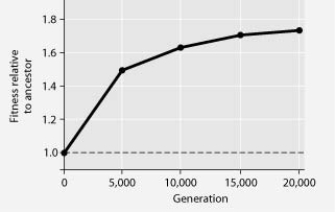Multiple Choice
In this eight-year experiment, 12 populations of E. coli, each begun from a single cell, were grown in low-glucose conditions for 20,000 generations. Each culture was introduced to fresh growth medium every 24 hours. Occasionally, samples were removed from the populations, and their fitness in low-glucose conditions was tested against that of members sampled from the ancestral (common ancestor) E. coli population. 
-
Compare the bacteria in the figure above in generation 1 and generation 20,000. The bacteria in generation 1 have a greater ________.
A) efficiency at exporting glucose from the cell to the environment
B) ability to survive on simple sugars, other than glucose
C) ability to synthesise glucose from amino acid precursors
D) reliance on glycolytic enzymes
Correct Answer:

Verified
Correct Answer:
Verified
Q2: Which of the following observations about flagella
Q37: The figure below depicts changes to the
Q41: Plantlike photosynthesis that releases O₂ occurs in<br>A)
Q44: Use the following information and figure to
Q45: A fish that has been salt-cured subsequently
Q47: The following table depicts characteristics of five
Q50: In a hypothetical situation, a bacterium lives
Q54: In prokaryotes, new mutations accumulate quickly in
Q56: Which of the following is least associated
Q57: Use the following information to answer the